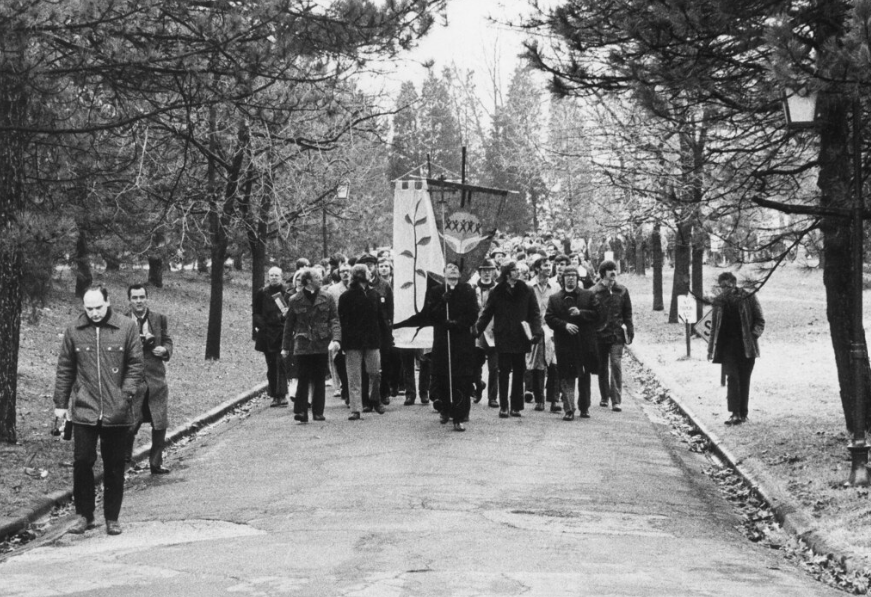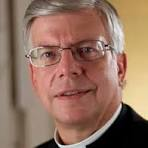Co-missioners,
Five Thursdays ago we announced an intention to devote some of our posts this year to the story of Seminex and its implications for the Church’s mission in 2024. The present work of Crossings is certainly rooted in that story, as we pointed out in our post of January 18.
A few days after that post the organizers of Crossings’ monthly Table Talk series hosted the first of two sessions devoted to Seminex. It unfolded as usual via Zoom. Upwards of sixty people joined the session. Of these a third had been invited to offer brief recollections of their Seminex experience and the way it affected them. Most were former students. One was a professor. Others were children of faculty members.
Today we share two sets of these recollections. One comes from Michael (Mike) Hoy, editor of Robert Bertram’s books and currently serving with Crossings as our interim text-study editor. The other is from Amandus (Mandy) Derr, now retired from a pastoral career spent at Grace Lutheran Church and School, Teaneck, New Jersey, and at Saint Peter’s Church [ELCA] in midtown Manhattan. Unlike Mike, Mandy was unable to attend the January Zoom session. He sent us his comments anyway, and for that we thank him. Neither Mike nor Mandy was on the Concordia Seminary campus on the day of the exile in 1974. This imparts a special angle to their reflections.
Some of you who read this were not at Seminex. We’ve done some judicious editing with this in mind, adding links to a thing or two mentioned along the way. Taking time to follow those links will enrich the story significantly.
As it happens, the 50th anniversary of Seminex falls exactly on February 19. That will be next Monday. A second Seminex-focused Table Talk will happen a day later, February 20. This session will focus on two questions. First, what was the Seminex experience really about? And second, how has it affected the church and our understanding of its mission? We can’t encourage you enough to join the conversation. That’s 1 p.m. Central Time next Tuesday. For the Zoom link, drop a note to our Table Talk coordinator, Cathy Lessmann.
Peace and Joy,
The Crossings Community
______________________________________________________________________
Seminex Recollections
by Michael Hoy and Amandus Derr
Question 1: What is your most significant memory of the Seminex experience and why?
Mike—
On the day Seminex was born I was a junior at Concordia Senior College [Fort Wayne, Indiana, an LCMS school designed specifically to prepare students for the seminary.] Over the next several months, our campus would play host to many Concordia Seminary students on moratorium as well as faculty from the seminary campuses of both Seminex and the LCMS. For the record, the latter didn’t make a very good showing—at least not to me. I had pretty much made up my mind that I would be going to Seminex well before I completed my studies at Fort Wayne.
For me, the most significant memory—not only the first time, but all other times afterward —was stepping out of the elevator on the eleventh floor of the old University Club building [in St. Louis, where Seminex was located.] There to greet me was [Professor Robert] Werberig’s art on the wall, the stump of Jesse with its shoot which would become the Seminex logo, as well as something I presumed were a symbol of the crown of thorns—perhaps to symbolize how this seminary and the people in this place shared or would get to share in the cross and crucifixion of our Lord. You wouldn’t know it, from all the joy I experienced there on my first visit.
Still, even as I accepted that I would be studying here for the next four years of my life, I was also deeply aware that there were no guarantees in coming here. What would my future hold? Will I ever find a vocation in the ordained ministry? A lot of the language at that time among the seminarians was about the possibility of serving maybe as “worker priest”, not about full-time ministry. The only promise I could count on, the only promise any of us could count on really, was the promise of our Lord and the promise of our baptism. In that sense, stepping on to the eleventh floor was a “leap of faith” in the Kierkegaardian sense of the term.
Mandy—
Because I was a vicar at Grace Lutheran Church and School, Teaneck, New Jersey in 1973-1974, my significant memories predate the formation of Seminex but are, in my opinion, very much a part of the Seminex experience.
1. [President] John Tietjen’s sermon at the opening of Concordia Seminary’s 1972 academic year. Entitled “Who wants to be First?”, it really set the stage for what the upcoming experiences would be all about, namely, the Gospel of God’s unconditional love as the central essential proclamation of Christ’s Church, and the cost proclaimers of that message would incur.
2. The formation of “Seminarians Concerned for Reconciliation Under the Gospel” by a number of us. Seminarians Concerned was born in the Seminary Bookstore (I was the student manager) in late 1972 and early 1973, on several Thursday evenings when the bookstore was open. Those of us who formed this were interested in providing a way to fund students and others in responding to synodical [LCMS] critics. We not only organized it, but we chose its symbol (an ‘eaten fish’ pendant that had just arrived at the bookstore and which we thought at first was ugly and unsellable – we sold thousands!), and the plan we hatched to get the list of delegates from the so-called “Frey-Lueking” group. [Pastors Bertwin Frey and Dean Lueking were leaders of the Missouri Synod’s “moderate” wing, supportive of Concordia Seminary’s faculty majority.] This organization turned out to be critical for funding the first [seminary] outreach in April 1973, the presence of several seminarians at the [LCMS’s] New Orleans convention in July 1973, and subsequently much of the early cost of starting up Seminex. It also provided the recognized organization in the 1973-1974 planning of the moratorium [declared by students when President Tietjen was suspended in January, 1974] and of the subsequent exile.
3. Robert Bertram’s chapel sermon right after Easter 1973 entitled “The Lively Use of the Risen Lord,” which was a perfect example of Law/Gospel (better: Judgment/Promise) theology useful in addressing the questions of biblical inerrancy. After having Bertram, Schroeder, and Walter Bouman for systematic theology, this was the single most succinct and helpful “lively use” of the hermeneutics we treasured.
4. John Tietjen’s address to the 1973 Missouri Synod Convention in New Orleans after the vote to “deal with the matter of John Tietjen.” (I was Concordia Seminary’s elected student representative). Again, a perfect use of Law/Gospel hermeneutics. [Tietjen’s remarks both before and after the vote are available on You Tube. The video is grainy. Even so it conveys the crackling drama of the occasion.]
Question 2: How has the Seminex experience affected you personally?
Mike—
While many of the faculty played a role in shaping my life at Seminex, two in particular stood out above the rest— the same two that stand out for many of us in Crossings —Bob Bertram and Ed Schroeder. Both would become for me mentors, colleagues, and very dear friends.
It was at Seminex that Bob taught me the gospel, and how deeply it is connected to our very faith that trusts it so. Faith is that which grasps and cherishes the gospel of Christ in the very face of all criticism, including most especially divine criticism. Christ gives us the promise that all criticism, even the criticism of the law, will never be for us the last word. Christ’s promise of mercy and forgiveness and life will be the last Word. You won’t find a more deep and profound meaning of the gospel and faith in all of the watered-down versions that dominate so many establishment theologies, including what I find far too much even in the ELCA. Many years after Seminex, that same theme about the gospel would be on display at Bob’s and Thelda’s home. There was a crucifix on the wall; and on that crucifix Bob had affixed a post-it with words clearly borrowed from Harry Truman, but written in Bob’s own impeccable penmanship – “The buck stops here.” It brought back so much about what Bob had taught throughout his life on the meaning of the gospel.
Ed Schroeder, of course, echoed many of the same themes that Bob did, and even credited Bob as the one who mentored him in the gospel. Among the many things that Ed especially helped me to appreciate and treasure was the meaning of the word “exile.” Ed took that seriously, so seriously that when all the rest of the faculty departed to other seminary campuses, he stayed in exile in St. Louis, teaching Crossings. Exile, as Ed understood it, points us toward a future homeland that no church institution or church body can ever fulfil. I sought to lift that up also in my introduction to Ed’s Seminex Remembered, even seeing how the words of Hebrews 11 apply so much to Ed and Bob and their spouses and many, many dear faithful saints from Seminex remembrances who have gone before us: “All of these died in faith without having received the promises, but from a distance they saw and greeted them. They confessed that they were strangers and foreigners on the earth, for people who speak in this way make it clear that they are seeking a homeland.”
The gospel, faith, exile. Those themes are what I remember most about Seminex. These have been cherished by me over all these fifty years, together with all the thorny scars and criticisms that have come along with them. But I have never regretted stepping off the elevator on the eleventh-floor.
Mandy—
The above events and the formation of Seminex—all based on what I have come to believe, teach, and confess, namely the Gospel of Jesus Christ understood from Scripture, Confessions, and daily experience as Judgment and Promise—shaped my personal and pastoral life completely. It is the process I’ve used in virtually every pastoral and church-related task. It was critical to my personal life when my first wife died five years into our marriage; critical to my work in the formation of the ELCA’s New Jersey Synod and subsequent service at its Secretary; critical to my passion for church unity and in interfaith relations; critical to everything I still do in my writing, teaching, preaching, and pastoral care. I simply cannot imagine what my life and ministry would be had I not learned the Law/Gospel interpretive principle.
Thursday Theology: that the benefits of Christ be put to use
A publication of the Crossings Community






You must be logged in to post a comment.